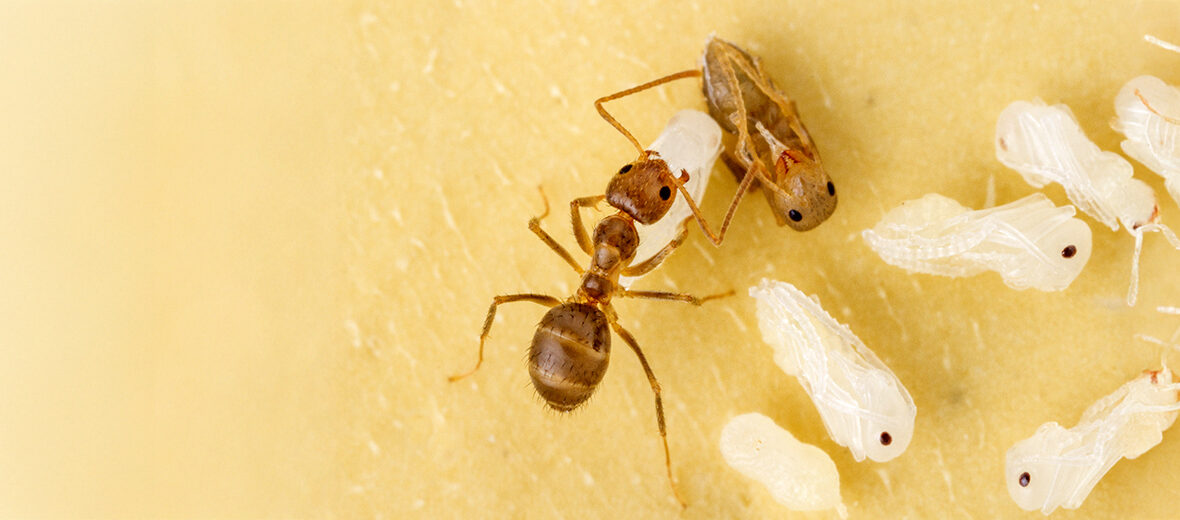
The Rasberry crazy ant, aka tawny crazy ant, is originally from South America but has expanded its territory to Central America, Mexico, and North America. These ants get their namesake “crazy” from the erratic movements they make when disturbed. They are abundant and widely distributed, thus not evaluated by the IUCN. Crazy ants are spreading and likely here to stay.
First the Stats…
Scientific name: Nylanderia fulva
Length: Up to .12 inch
Lifespan: Up to 3+ years
Now on to the Facts!
1.) They get the first part of their name due to Tom Rasberry, an exterminator in Texas, United States in 2002 who noticed the ants were spreading rapidly.
2.) Colonies tend to have multiple queens, which also aids in their survival and ability to spread.
3.) As of 2012, these critters have established colonies in every state along the Gulf of Mexico including at least 27 counties in Southeast Texas.
4.) Like many other species of ants they cultivate aphids to gain a steady supply of honeydew (a substance excreted by aphids that tastes sweet to ants).
5.) Chickens have died of asphyxiation while larger animals, like cattle, have been attacked around the eyes, nostrils, and hooves.
But wait, there’s more on the Rasberry crazy ant!
6.) Grasslands have literally dried out because of the increase in plant-sucking aphids, that the ants cultivate.
7.) When attacked, these ants, just like other formicine ants, can bite (but they don’t sting) and excrete formic acid through a hairy circle or acidopore on the end of their abdomen, using it as a venom, which causes a slight pain that quickly fades.
Did you know…?
In 2014, it was noted that they produce and cover themselves with formic acid as an antidote to the fire ant’s venom. It’s the first known example of an insect being able to neutralize another insect’s venom, an ability theorized to have evolved in South America.
8.) After exposure to fire ant venom, these ants retreat, cover themselves with formic acid, then return to the fight. This is the first known example of an ionic liquid in nature which comes from the mixing of formic acid with venom from fire ants.
9.) Sweet liquids, particularly those produced by insects like aphids, mealybugs, and scale insects, as well as plant nectar are all readily consumed.
10.) It is unknown why colonies of these ants are attracted to electrical equipment. Infestations in electrical equipment can result in short circuits, sometimes because the ants chew through insulation and wiring. Overheating, corrosion, and mechanical failures also result from dead ants and nest detritus gathering in electrical devices.
But wait, there’s still more on the Rasberry crazy ant!
11.) When an ant is electrocuted, it tends to release an alarm pheromone when it dies, which causes other ants to race over and search for attackers. If a great enough number of ants gather, it tends to short out various systems.
12.) Their annual rate of spread by ground migration as about up to 1,181 feet per year in neighborhoods and industrial areas.
13.) When carried by people, animals, and vehicles (in trash for example), the rate is far greater – up to 5 miles per year.
14.) In June 2008, the United States Environmental Protection Agency (EPA) granted temporary approval for the use of fipronil, a termite control agent, to control these ants. Its use is currently restricted only to infested counties.
Now a Short Rasberry Crazy Ant Video!
Be sure to share & comment below! Also, check out the Critter Science YouTube channel. Videos added regularly!
Want to suggest a critter for me to write about? Let me know here.
Some source material acquired from: Wikipedia
Photo credit: Insects Unlocked



